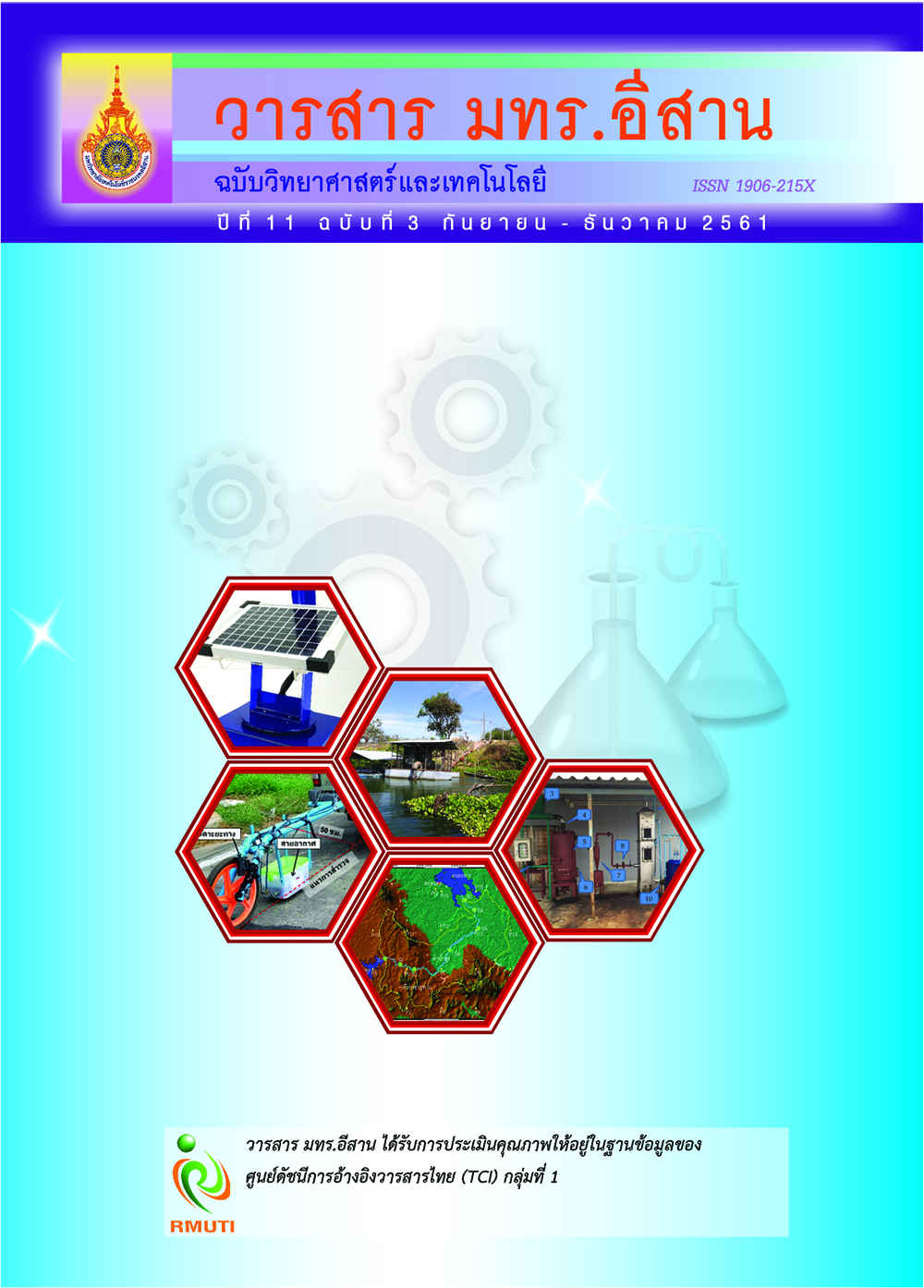The Development of a Dual-Axis Solar Tracking System Using the Optimization Method
Main Article Content
Abstract
This paper presents the development of a dual-axis solar tracking system with four-point of light intensity comparison method. The maximum of light intensity is used to calculate direction of the sun with the optimization equation. The data of light intensity is processed to control the motor by the AVR microcontroller. Dual-axis solar tracking system will track the sun in highest light position precisely and produce the maximum power. In this research, a dual-axis solar tracking system applied with 5 watts 21.5 volt photovoltaic module, which compares the electrical energy values between a solar panel fixed installation modules and the proposed modules. As for the experiment results, it was found that the dual-axis solar tracking system increased the voltage by 4.28 %, the electric current increased by 44.04 % and electric power increased by 47.24 % compared with a solar panel fixed installation modules. The result showed that the developed dual-axis solar tracking system can increase efficiency of the electrical energy. Moreover, the developed tracking system can be applied to other devices as well.
Article Details
References
[2] B. Khadidja, K. Dris, A. Boubeker and S. Noureddine. (2014). Optimisation of a Solar Tracker System for Photovoltaic Power Plants in Saharian region, Example of Ouargla. Energy Procedia. Vol. 50, pp. 610-618
[3] Chow, L. S. and Abiera, M. (2013). Optimization of Solar Panel with Solar Tracking and Data Logging. IEEE Student Conference on Research and Development (SCOReD). 16 -17 December 2013. Putrajaya, Malaysia. pp. 15-19. DOI: 10.1109/SCOReD.2013.7002532
[4] C. Alexandru. (2013). Design and Optimization of a Monoaxial Tracking System for Photovoltaic Modules. Journal of Solar Energy. Vol. 2013, p. 6. DOI: 10.1155/2013/586302
[5] Department of Alternative Energy Development and Efficiency Ministry of Energy. (2015). Solar Energy. Annual Report 2015 Department of Alternative Energy Department and Efficiency. Access (12 April 2018). Available (https://www.dede.go.th/ewt_news.php?nid=774&fi lename=index)
[6] Department of Alternative Energy Development and Efficiency Ministry of Energy. (2014). Solar System. Summary of Solar Energy Systems by Department of Alternative Energy Development and Efficiency. Access (12 April 2018). Available (https://www.dede.go.th)
[7] Sadeque, F. and Ahsan, Md. Q. (2014). Design and Implementation of a Single-Axis Automatic Solar Tracking System. GUB Journal of Science and Engineering. Vol. 1, Issue 1, pp. 1-5
[8] C. Alexandru. (2014). A Comparative Analysis Between the Tracking Solutions Implemented on a Photovoltaic String. Journal of Renewable and Sustainable Energy. Vol. 6, Issue 5, pp. 1-17. DOI: 10.1063/1.4899078
[9] I. Stamatescu, G. Stamatescu, N. Arghira, I. Făgărăan and S. S. Iliescu. (2014). Fuzzy Decision Support System for Solar Tracking Optimization. 12th International Conference on Development and Application Systems. Suceava, Romania, May 15-17. pp. 16-20
[10] J. Zhao and Z. Liand and T. Ai. (2015). Research on Optimization of Output Characteristics of Solar Power System Based on Novel Incremental Conductance Method. 8th International Symposium on Computational Intelligence and Design (ISCID). 12 May 2016. Hangzhou, China. pp. 138-142. DOI: 10.1109/ISCID.2015.230
[11] P. Thanapat and D. Akekachai. (2007). The Sun Tracking System Using a CPLD-based Position Sensor. Access (12 April 2018). Available (https://www.researchgate.net/publication/283291092)
[12] Somphop, P. (2015). Automation Control Solarcell. Princess of Naradhiwats University Journal. Vol. 7, No. 1, pp. 81-91
[13] Korntham, S. and Apinya, B. (2013). The Development of A Low-cost Solar Tracking System for Renewable Energy Applications. Bulletin of Applied Science. Vol. 2, No. 2, pp. 90-99
[14] Adafruit. (2018). Photocells and Measuring Light. Access (12 April 2018). Available (https://learn.adafruit.com/photocells/measuring-light)


